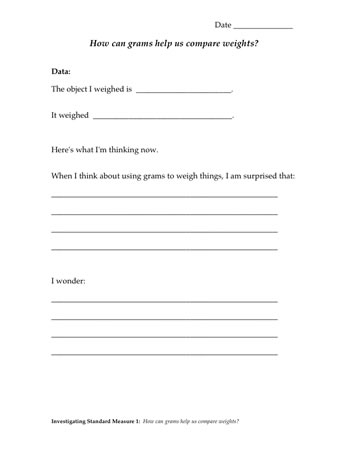How can grams help us compare weights?
Plan Investigating Standard Measures 1
In their last investigations, students experimented with nonstandard units of meaure — paper clips, washers, and counting bears. In this investigation they explore — perhaps for the first time — an important unit of weight in the metric system: the gram.
Students weigh a variety of familiar objects in terms of grams and place those objects on the weight line. They then study the distribution of objects on the weight line, comparing size and weight. By the end of the investigation, students will be thinking of objects in terms of their gram weight. They will also be noticing that size and weight do not always correspond.
Learning Goals
- to use grams as a standard unit for measuring the weight of objects
- to think about the relationship between size and weight
| Sequence of experiences | ||
|---|---|---|
| 1. Ask the question | All Class | 10 Mins |
| 2. Weigh selected objects | Small Groups | 15 Mins |
| 3. Place the objects on the weight line | All Class | 10 Mins |
| 4. Make meaning | All Class | 10 Mins |
Materials and Preparation
For the class:- Post the investigation question in a place where all students can see it.
- The plastic weight line — If your weight line has been left in view since the last class, make sure the students can get to it. If not, place the weight line in an easily accessible place.
- 1 gram weight set
- 1 index card labeled “Grams”
- 1 object weighing approximately 1 pound (450 grams)
- 1 object for each student to weigh from the following:
Objects from the kit:
- plastic spoon
- metal spoon
- counting bear
- weight line
- wooden spoon
- key
- large steel washer
- rubber eraser
Suggested objects from the classroom:
- roll of masking tape
- scissors
- baseball hat
- 3 pencils (different lengths)
- student notebook
- 2 different crayons
- roll of clear tape
- felt tip pen
- pen
- stapler
- large binder clip
For each group:
- 2 pan balances
- 1 gram weight set
- 1 gram weight
- 1 large paper clip





